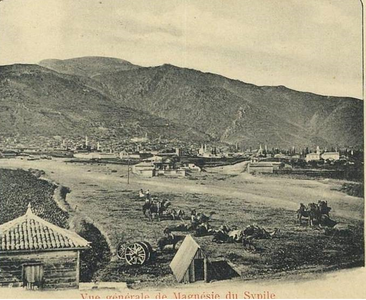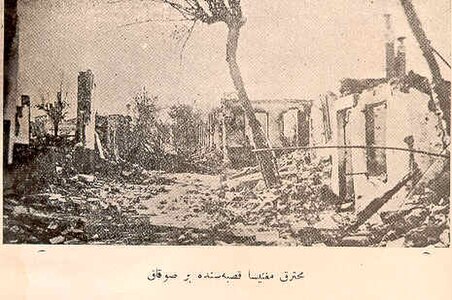Incendio de Manisa , la enciclopedia libre
| Incendio de Manisa | ||
|---|---|---|
| Coordenadas | 38°36′43″N 27°25′35″E / 38.6119, 27.4264 | |
El incendio de Manisa (en turco: Manisa yangını) se refiere a la quema de la ciudad turca de Manisa.[1] Comenzó en la noche del martes 5 de septiembre de 1922 y continuó hasta el 8 de septiembre.[1] Fue iniciado y organizado por las tropas griegas en retirada,[1][2] durante la guerra greco-turca (1919-1922). Como resultado, el 90 % de los edificios de la ciudad fueron destruidos (más de 10 000 edificios).[1][3] El número de víctimas en la ciudad y la región adyacente fue estimado en varios millares por el cónsul estadounidense James Loder Park.[3] Fuentes turcas afirman que 4355 personas murieron en la ciudad de Manisa.[4] La población de la ciudad antes del suceso se estima que era de aproximadamente 40 000-50 000 habitantes. Los eventos se describen en la literatura turca, por ejemplo por los autores Falih Rıfkı Atay y Ilhan Berk. Se estimó el daño total en más de 50 millones de liras.[5]
Gulfem Kaatçılar İrem fue testigo del fuego cuando era una niña y recuerda:[6]
Después de escapar de la milicia hacia el amanecer, trepamos por un arroyo para escondernos en las colinas. A medida que ascendíamos, la ciudad ardía, éramos iluminados por el resplandor y sentíamos el calor de las llamas. Ardió durante tres días y tres noches. Vi los cristales de las ventanas explotar como bombas. (...) Vacas y caballos muertos, hinchados con sus patas hacia arriba. Viejos árboles derribados, con sus raíces ardiendo como (...). No olvido aquellas cosas. El calor, el hambre, el miedo, el olor. Después de tres días vimos levantarse el polvo en el valle de abajo. Soldados turcos a caballo; pensamos que eran griegos que venían a matarnos en las colinas. Recuerdo tres soldados portando banderas verdes y rojas. La gente besó los cascos de sus caballos, gritando «nuestros salvadores han venido».
Galería
[editar]- Anatolia occidental.
- Descripción general antes del incendio.
- Una imagen de una calle después del incendio.
- Mapa de la ciudad (antes del incendio).
Referencias
[editar]- ↑ a b c d Emecen, Feridun Mustafa (2006). Tarihin içinde Manisa. Manisa Belediyesi. p. 6. ISBN 9789759550608. «Yunan kuvvetleri çekilirken 5 Eylül Salı günü şehri ateşe verdiler, akşam söndürülen yangın sabah çarşı kesiminde tekrar başladı ve 8 Eylül'de kendiliğinden söndü. Yangın sırasında halk dağlara kaçtı, bu büyük yangın neredeyse şehrin tamamını etkiledi, 10.700 ev, on üç cami, 2728 dükkân, on dokuz han yandı, Manisa tam bir harabeye dönüştü. 8 Eylül’de Türk birlikleri Manisa yakınlarındaki küçük bir çarpışmanın ardından şehre girdi. Cumhuriyet döneminde bu tahribatın izleri kapandı ve şehir yeniden gelişmeye başladı. (español) "Las fuerzas griegas, mientras se retiraban, prenden fuego a la ciudad el martes 5 de septiembre, que se extinguió en la noche, pero comenzó de nuevo a la mañana siguiente, en el sector del mercado y el 8 de septiembre se extinguió por sí mismo. Durante el incendio el pueblo huyó a las montañas, este gran fuego afectó a casi toda la ciudad, 10 700 casas, trece mezquitas, 2728 tiendas y posada diecinueve fueron quemados, Manisa se convirtió en una ruina completa. El 8 de septiembre después de una colisión menor cerca de Manisa, las tropas turcas entraron en la ciudad. En el período republicano, los rastros de esta destrucción desaparecieron, y la ciudad comenzó a florecer de nuevo. "».
- ↑ Freely, John (2010). Children of Achilles: The Greeks in Asia Minor Since the Days of Troy. .B.Tauris. p. 212. ISBN 9781845119416. «Manisa, which was burned to the ground by the Greeks when they evacuated the town.»
- ↑ a b U.S. Vice-Consul James Loder Park to Secretary of State, Smyrna, 11 April 1923. US archives US767.68116/34
Consul Park concluded:
"1. The destruction of the interior cities visited by our party was carried out by Greeks."
"2. The percentages of buildings destroyed in each of the last four cities referred to were: Manisa 90 percent, Cassaba (Turgutlu) 90 percent, Alaşehir 70 percent, Salihli 65 percent."
"3. The burning of these cities was not desultory, nor intermittent, nor accidental, but well planned and thoroughly organized."
"4. There were many instances of physical violence, most of which was deliberate and wanton. Without complete figures, which were impossible to obtain, it may safely be surmised that 'atrocities' committed by retiring Greeks numbered well into thousands in the four cities under consideration. These consisted of all three of the usual type of such atrocities, namely murder, torture and rape."
"Cassaba (present day Turgutlu) was a town of 40,000 souls, 3,000 of whom were non-Muslims. Of these 37,000 Turks only 6,000 could be accounted for among the living, while 1,000 Turks were known to have been shot or burned to death." - ↑ Ergül, Teoman (1991). Kurtuluş Savaşında Manisa, 1919-1922. Manisa Kültür Sanat Kurumu. p. 337. «Daha acısı 3500 kişi ateşte yakılmak ve 855 kişi kurşunlanmak suretiyle öldürülmüştü. Üç yüz kızın ırzına geçilmişti. Sadece bir mahalleden 500 kişi götürülmüştü. Ölü veya diri oldukları hakkında bir bilgi alınamamiştır. (español) "El más doloroso, que 3.500 personas murieron quemadas y 855 personas murieron por armas de fuego. Fueron violadas trescientas niñas. De un solo distrito, 500 personas fueron deportadas. Se desconoce su destino."».
- ↑ Su, Kamil (1982). Manisa ve yöresinde işgal acıları. Kültür ve Turizm Bakanlığı. pp. 26-87.
- ↑ Neyzi, Leyla (2008). Remembering Smyrna/Izmir. History and Memory. p. 115. «After escaping the militia towards dawn, we climbed up a dry stream bed to hide in the hills. As we climbed, the city was burning, and we were lit by its light and warmed by its heat. It burned for three days and three nights. I saw the windowpanes of houses explode like bombs. Sacks of grapes stuck together, bubbling like jam. Dead cows and horses, balloons with their legs in the air. Ancient trees keeled over, their roots burning like logs. I did not forget these things. The heat, the hunger, the fear, the smell. After three days we saw the dust rise in the valley below. Turkish soldiers on horseback; we thought they were Greeks come to kill us in the hills. I remember three soldiers carrying green and red flags. People kissed the hooves of their horses, crying “Our saviors have come.”..."As Manisa was torched by the Greeks, the townspeople fled to the hills. It was here that they would remain “for three days and three nights.”».


 French
French Deutsch
Deutsch


